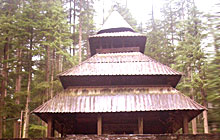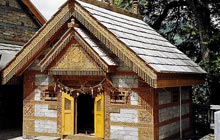
Temples of Kullu Valley : Basheshwar Mahadev Temple is believed to be the largest and most spectacularly built. Built in typical Pahari style, Bijli Mahadev Temple is one of the toughest to reach. It is dedicated to Lord Shiva and derives its name from the fact that the shivling inside has, time and again, been shattered by lightening. The priests put together the shivling with ghee. Similar in style to the Bijli Mahadev temple, the Bhuvneshwari Temple is also built in Pahari style. The temple walls are adorned with Kangra-style paintings of Durga and the stone lion placed in the courtyard is built beautifully. Vaishno Devi Temple is a relatively new temple and is located on the National Highway near Kullu. Dedicated to the patron deity of Kullu, Raghunath Temple is the site of the famous Kullu Dusshera celebrations. Legends have it that Lord Rama performed the Ashwamedha Yajna before this very idol.
Temples of Manali : One of the most important temples in Manali is the Manu Rishi Temple, which is a five-storey pagoda-like structure with a brass kalasa crowning the top. This temple is dedicated to Manu, who is said to be the first human ever. Vashishtha Temple is dedicated to sage Vashishtha and built in true Pahadi-style. The patron deity inside is a stone idol clad in dhoti, cap and a white shawl. Hadimba Devi Temple is the most important and prayed at temple here. The temple is four-storeyed, pagoda-shaped and showcases intricate carvings of dancers at the entrance. The temple contains an idol of Goddess Hadimba seated on a rock. The Left Bank in Manali is home to the Gauri Shankar Temple built in pyramid style and housing idols of Parvati and Shiva. Close to it is the Sandhya Devi Temple built in pahari style with a sloping roof and square base. Along with a stone image of Goddess Sandhya, an idol of Lord Ganesha can also be found inside. The Dashal Temple is dedicated to Lord Shiva and is a beautiful masterpiece. Intricate carvings adorn the walls of this temple.
Temples of Banjar : The main temple of the Banjar Valley is Shringa Rishi Temple dedicated to Shringa Rishi, the patron god of Banjar. The temple is a combination of a pagoda and pahari-style of architecture. Made of wood, the temple also has four roofs and an idol made of stone and brass, who is kept in his chariot all the time. Built like a fort, the Parshuram Temple houses a three-headed statue of Parshuram, which the third eye fitted with a diamond. The Ambika Temple was believed to have been built by Parshuram for his mother. It houses an idol of Ambika and a pair of lions placed before it. Carvings of fighting animals also adorn the walls.
Temples of Manikaran : Manikaran is the site of the natural hot water springs believed to have medicinal powers. The Rama Temple here is built in pyramidal style and is dedicated to Lord Rama. The temple complex sports three halls and forty rooms where devotees stay and a free meal or langar is also served to them. Manikaran is also home to the Gurudwara of Shri Narayan Hari, who built it almost 60 years back. Today it provides the daily langar service (free meal) to over 4000 people.

Temples of Naggar : The Murlidhar Temple, dedicated to Lord Krishna, Radha, Garuda and Laxminarayana has a striking spire on top. It is also the site of the annual Dusshera Festival. The Tripura Sundri Temple is one of the most well-known temples made in wood and sporting three-storeys. It looks similar to the Hadimba Devi Temple with a kalasa crowning the topmost storey. The temple has stone idols of Ganesha, Vishnu, Brahma, Laxmi Narayan, Shiva and Parvati. Jagati Patt Temple is a wooden temple, whose highlight is a slab believed to have been brought here by the gods from the Bhrigu Tung Peak. Similar to Manali, there is a Gauri-Shankar Temple, dedicated to Parvati and Shiva. The main sanctum has engraved figures of Lord Ganesha, floral patterns and musical instruments.
Naggar Castle : Today converted into a heritage hotel, the Naggar Castle was built almost 600 years ago as home to the Raja of Kullu. It offers spectacular views of the Naggar Valley and houses the wooden Jagati Patt Temple in its complex. It is also home to the Roerich Art Gallery that houses paintings of Russian artist Nicholas Roerich. The gallery has also preserved original creations of the Himalayas done by Roerich, his quotations and notes left by his visitors.
Open from: 10.00 am-5.00 pm (Monday closed)
Urusvati Himalayan Folk Art Museum : Also located in Naggar, this folk art museum was once the research centre of the Himalayan region, and Indian and Tibetan medicine systems, started by Nicholas Roerich. This museum houses a fine collection of embroideries and folk art objects. Russian art, musical instruments, dolls and utensils are other popular displays. Paintings done by Roerich and other Indian and Russian artists also adorn the walls. Don’t miss the stone carvings of gods, pieces of crystal and wood, and the traditional garb of Kullu, Lahaul-Spiti, Tibet and Ladakh.
Dechen Choekhor Monastery : Located in Manali, this newly-built monastery owes its origin to the one in Tibet. It houses monks and lamas, who are trained in Buddhism. The monastery also manages a Thangka School of Arts and a carpet-weaving centre – both aiming at preserving the Tibetan Art. The interiors are full of paintings depicting scenes from Buddha’s life and a Kalachakra (wheel of life), which depicts the circle of life.
Gadhan Thekchoking Gompa : Located near the Mall, this gompa is particularly noted for its bright frescoes and a medium-sized Buddhist statue.
Wildlife Sanctuaries : The Kullu Valley is home to five wildlife sanctuaries, namely Great Himalayan National Park, Khokhan Sanctuary, Kais Sanctuary, Manali Sanctuary and Kanawar Sanctuary. Here you’d find some of the most endangered species including Musk Deer, Brown Bear, Snow Leopard and Cheer Pheasant. It is estimated that the largest number of the Himalayan Tahr are found in the Kanawar Sanctuary. Visit these sanctuaries in the summer months or early winters when traveling to these heights are relatively easy.
Waterfalls : Rahla Fall almost 27 km from Manali is spectacular with the Beas River gushing down 50 mts. Similarly, the Palani Fall is located near the Bijli Mahadev Temple and cascades down 150 mts. Both these falls are popular picnic spots. In addition, the falls are also the site of the annual fair held in March attended by a large number of people from across the country.
Hot Water Springs : Kullu has several hot water springs dotting its landscape, believed to have curative powers. Among the most visited is the Kheerganga at Manikaran. These hot water springs seem to emerge from the rocks and are whitish in colour. A dip here is believed to cure gastric problems and rheumatic pains. For skin diseases, a dip in the hot water springs at Kalath, Manali is a must. Vashishtha Springs are also famous for the Turkish baths built by the Tourism Department.
Rafting : The Beas River is a well known spot for white water rafting, canoeing and kayaking. Several events and competitions are organized by the clubs here. The equipments for your adventure sessions are also provided by the clubs.
Solang Valley : This is one of the most popular treks undertaken from Manali to Solang Valley and the Beas Kund below Hanuman Tibba. Set amidst pine and deodar trees, the Solan Valley’s slopes are also the site of the State and National Winter Sports.
Snow Point or Rohtang Pass: Catch beautiful glimpses of the majestic Himalayas from here. Rohtang Pass is the highest point on the National Highway and is especially popular for skiing since it experiences heavy snowfall. The Dassaur Lake close by is the source of the River Beas.
Jallori Pass : Located between the Ani and Banjar Valley, the pass offers spectacular views of the mountains and valleys. The pass is closed during winter for vehicles because of heavy snowfall.
Skiing: Manali is known as one of the best skiing spots. Especially important are Solang Nullah, Patalsu, Kothi, Marhi and Rohtang slopes. For summer skiing, head out to Patalsu and Rohtang slopes. You can also enjoy the National Skiing Competition organized at Solang Nullah.
Paragliding : Solang Nullah is also a popular paragliding spot and there are clubs that offer packages in paragliding. You can hire equipments from private clubs in and around Manali.
Angling : The Beas River is an angler’s delight and the Himachal Pradesh Fisheries Department allows tourists to enjoy a session of trout angling. Among the known fishing spots are Kalath, Katrain, Raison, Seo Bagh, River Parbati and Tirthan Stream. During winters, trout fishing is not allowed and in season, you need to have a permit from the tourist information centres or the fisheries office.
Note – One permit would allow you 6 fishes
The Western Himalayan Institute of Mountaineering : Adventure seekers can enroll themselves at the Mountaineering Institute, which runs courses in techniques of rock climbing, ice climbing, snow craft, ice craft and river crossing. You can also hire trekking and climbing equipments from here. |